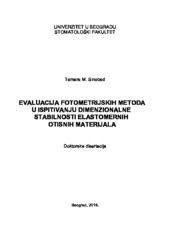Evaluation of photometric methods in assessment of dimensional stability of elastomeric impression materials
Evaluacija fotometrijskih metoda u ispitivanju dimenzionalne stabilnosti elastomernih otisnih materijala
2016
Аутори
Sinobad, TamaraОстала ауторства
Obradović-Đuričić, KosovkaNikolić, Zoran
Dodić, Slobodan
Lazić, Vojkan
Popović, Dušan
Докторска теза (Објављена верзија)
Метаподаци
Приказ свих података о документуАпстракт
Dental impression materials are used to reproduce the form and relations of teeth and surrounding oral tissues, and the impressions are used for fabricating diagnostic and master casts. Dimensional stability of elastomeric impression materials under various conditions, is pivotal factor for the accuracy and durability of the final prosthetic restorations. It is defined as the ability of a material to retain its size and form over time. The aim of this study was to evaluate different possibilities of the original photometric methods in assessment of dimensional stability of elastomeric impression materials and to determine their efficiency and precision in comparison with the reference method recommended by the valid standards for dental elastomeric impression materials (ISO 4823:2000, ANSI/ADA Specification No.19). Five elastomeric impression materials were used in this study: two condensation silicones (Oranwash L - Zhermack and Xantopren L blue - Heraeus Kulzer), two addi...tion silicones (Elite HD + light body - Zhermack and Variotime Light Flow - Heraeus Kulzer) and one polyether (ImpregumTM Soft 3M ESPE). A specific stainless steel test block, made according to the recommendations of ISO standard, was used for the fabrication of the samples of tested impression materials. Dimensional stability of the impression materials was examined as a function of time (5min, 30min, 1h and 24h after removal from the test block) at the temperatures of 23ºC, 35ºC and 40ºC. The effect of each applied disinfectant (5.25% NaOCl, glutaraldehyde, benzalkonium chloride – Sterigum and aerosol with ethanol and isopropanol - Zeta 7) was tested as well..
U stomatologiji se otisni materijali upotrebljavaju za reprodukciju oblika i odnosa zuba i okolnih oralnih tkiva, a dobijeni otisci se koriste za izradu dijagnostičkih i master modela. Dimenzionalna stabilnost elastomernih otisnih materijala u različitim uslovima, važan je faktor koji direktno utiče na preciznost i trajnost indirektno izrađenih definitivnih zubnih nadoknada. Definiše se kao sposobnost materijala da zadrži svoju veličinu i oblik tokom vremena. Cilj ovog istraživanja je ispitivanje različitih mogućnosti originalnih fotometrijskih metoda u proceni dimenzionalne stabilnosti elastomernih otisnih materijala i utvrđivanje njihove efikasnosti i preciznosti u poređenju sa referentnom metodom koju preporučuju važeći standardi za elastomerne otisne materijale u stomatologiji (ISO 4823:2000, ANSI/ADA Specifikacija br.19). Za potrebe ovog istraživanja korišćeno je pet elastomernih otisnih materijala: dva kondenzaciona silikona (Oranwash L–Zhermack i Xantopren L blue–Her...aeus Kulzer), dva adiciona silikona (Elite HD+ light body–Zhermack i Variotime Light Flow–Heraeus Kulzer) i jedan polietar (ImpregumTM Soft 3M ESPE). Uzorci ispitivanih otisnih materijala dobijeni su iz specijalne modle od nerđajućeg čelika koja je izrađena prema preporukama važećih standarda. Dimenzionalna stabilnost otisnih materijala ispitana je u zavisnosti od vremena (5min, 30min, 60min i 24h od momenta odvajanja otiska od modle), pri temperaturama od 23ºC, 35ºC i 40ºC, kao i pod uticajem različitih dezinficijenasa (5,25% NaOCl, glutaraldehid, benzalkonijum hlorid –Sterigum i sprej na bazi etanola i izopropanola – Zeta 7)...
Кључне речи:
dimensional stability / dental impression materials / silicones / polyether / disinfection / standards / photometric methods / dimenzionalna stabilnost / stomatološki materijali za otiske / silikoni / polietar / dezinfekcija / standardi / fotometrijske metodeИзвор:
2016Издавач:
- Univerzitet u Beogradu, Stomatološki fakultet
URI
http://eteze.bg.ac.rs/application/showtheses?thesesId=3935https://fedorabg.bg.ac.rs/fedora/get/o:13235/bdef:Content/download
https://fedorabg.bg.ac.rs/fedora/get/o:13308/bdef:Izvestaj/download
http://vbs.rs/scripts/cobiss?command=DISPLAY&base=70036&RID=48250127
http://nardus.mpn.gov.rs/123456789/6744
https://smile.stomf.bg.ac.rs/handle/123456789/992
Колекције
Институција/група
Stomatološki fakultetTY - THES AU - Sinobad, Tamara PY - 2016 UR - http://eteze.bg.ac.rs/application/showtheses?thesesId=3935 UR - https://fedorabg.bg.ac.rs/fedora/get/o:13235/bdef:Content/download UR - https://fedorabg.bg.ac.rs/fedora/get/o:13308/bdef:Izvestaj/download UR - http://vbs.rs/scripts/cobiss?command=DISPLAY&base=70036&RID=48250127 UR - http://nardus.mpn.gov.rs/123456789/6744 UR - https://smile.stomf.bg.ac.rs/handle/123456789/992 AB - Dental impression materials are used to reproduce the form and relations of teeth and surrounding oral tissues, and the impressions are used for fabricating diagnostic and master casts. Dimensional stability of elastomeric impression materials under various conditions, is pivotal factor for the accuracy and durability of the final prosthetic restorations. It is defined as the ability of a material to retain its size and form over time. The aim of this study was to evaluate different possibilities of the original photometric methods in assessment of dimensional stability of elastomeric impression materials and to determine their efficiency and precision in comparison with the reference method recommended by the valid standards for dental elastomeric impression materials (ISO 4823:2000, ANSI/ADA Specification No.19). Five elastomeric impression materials were used in this study: two condensation silicones (Oranwash L - Zhermack and Xantopren L blue - Heraeus Kulzer), two addition silicones (Elite HD + light body - Zhermack and Variotime Light Flow - Heraeus Kulzer) and one polyether (ImpregumTM Soft 3M ESPE). A specific stainless steel test block, made according to the recommendations of ISO standard, was used for the fabrication of the samples of tested impression materials. Dimensional stability of the impression materials was examined as a function of time (5min, 30min, 1h and 24h after removal from the test block) at the temperatures of 23ºC, 35ºC and 40ºC. The effect of each applied disinfectant (5.25% NaOCl, glutaraldehyde, benzalkonium chloride – Sterigum and aerosol with ethanol and isopropanol - Zeta 7) was tested as well.. AB - U stomatologiji se otisni materijali upotrebljavaju za reprodukciju oblika i odnosa zuba i okolnih oralnih tkiva, a dobijeni otisci se koriste za izradu dijagnostičkih i master modela. Dimenzionalna stabilnost elastomernih otisnih materijala u različitim uslovima, važan je faktor koji direktno utiče na preciznost i trajnost indirektno izrađenih definitivnih zubnih nadoknada. Definiše se kao sposobnost materijala da zadrži svoju veličinu i oblik tokom vremena. Cilj ovog istraživanja je ispitivanje različitih mogućnosti originalnih fotometrijskih metoda u proceni dimenzionalne stabilnosti elastomernih otisnih materijala i utvrđivanje njihove efikasnosti i preciznosti u poređenju sa referentnom metodom koju preporučuju važeći standardi za elastomerne otisne materijale u stomatologiji (ISO 4823:2000, ANSI/ADA Specifikacija br.19). Za potrebe ovog istraživanja korišćeno je pet elastomernih otisnih materijala: dva kondenzaciona silikona (Oranwash L–Zhermack i Xantopren L blue–Heraeus Kulzer), dva adiciona silikona (Elite HD+ light body–Zhermack i Variotime Light Flow–Heraeus Kulzer) i jedan polietar (ImpregumTM Soft 3M ESPE). Uzorci ispitivanih otisnih materijala dobijeni su iz specijalne modle od nerđajućeg čelika koja je izrađena prema preporukama važećih standarda. Dimenzionalna stabilnost otisnih materijala ispitana je u zavisnosti od vremena (5min, 30min, 60min i 24h od momenta odvajanja otiska od modle), pri temperaturama od 23ºC, 35ºC i 40ºC, kao i pod uticajem različitih dezinficijenasa (5,25% NaOCl, glutaraldehid, benzalkonijum hlorid –Sterigum i sprej na bazi etanola i izopropanola – Zeta 7)... PB - Univerzitet u Beogradu, Stomatološki fakultet T1 - Evaluation of photometric methods in assessment of dimensional stability of elastomeric impression materials T1 - Evaluacija fotometrijskih metoda u ispitivanju dimenzionalne stabilnosti elastomernih otisnih materijala UR - https://hdl.handle.net/21.15107/rcub_nardus_6744 ER -
@phdthesis{
author = "Sinobad, Tamara",
year = "2016",
abstract = "Dental impression materials are used to reproduce the form and relations of teeth and surrounding oral tissues, and the impressions are used for fabricating diagnostic and master casts. Dimensional stability of elastomeric impression materials under various conditions, is pivotal factor for the accuracy and durability of the final prosthetic restorations. It is defined as the ability of a material to retain its size and form over time. The aim of this study was to evaluate different possibilities of the original photometric methods in assessment of dimensional stability of elastomeric impression materials and to determine their efficiency and precision in comparison with the reference method recommended by the valid standards for dental elastomeric impression materials (ISO 4823:2000, ANSI/ADA Specification No.19). Five elastomeric impression materials were used in this study: two condensation silicones (Oranwash L - Zhermack and Xantopren L blue - Heraeus Kulzer), two addition silicones (Elite HD + light body - Zhermack and Variotime Light Flow - Heraeus Kulzer) and one polyether (ImpregumTM Soft 3M ESPE). A specific stainless steel test block, made according to the recommendations of ISO standard, was used for the fabrication of the samples of tested impression materials. Dimensional stability of the impression materials was examined as a function of time (5min, 30min, 1h and 24h after removal from the test block) at the temperatures of 23ºC, 35ºC and 40ºC. The effect of each applied disinfectant (5.25% NaOCl, glutaraldehyde, benzalkonium chloride – Sterigum and aerosol with ethanol and isopropanol - Zeta 7) was tested as well.., U stomatologiji se otisni materijali upotrebljavaju za reprodukciju oblika i odnosa zuba i okolnih oralnih tkiva, a dobijeni otisci se koriste za izradu dijagnostičkih i master modela. Dimenzionalna stabilnost elastomernih otisnih materijala u različitim uslovima, važan je faktor koji direktno utiče na preciznost i trajnost indirektno izrađenih definitivnih zubnih nadoknada. Definiše se kao sposobnost materijala da zadrži svoju veličinu i oblik tokom vremena. Cilj ovog istraživanja je ispitivanje različitih mogućnosti originalnih fotometrijskih metoda u proceni dimenzionalne stabilnosti elastomernih otisnih materijala i utvrđivanje njihove efikasnosti i preciznosti u poređenju sa referentnom metodom koju preporučuju važeći standardi za elastomerne otisne materijale u stomatologiji (ISO 4823:2000, ANSI/ADA Specifikacija br.19). Za potrebe ovog istraživanja korišćeno je pet elastomernih otisnih materijala: dva kondenzaciona silikona (Oranwash L–Zhermack i Xantopren L blue–Heraeus Kulzer), dva adiciona silikona (Elite HD+ light body–Zhermack i Variotime Light Flow–Heraeus Kulzer) i jedan polietar (ImpregumTM Soft 3M ESPE). Uzorci ispitivanih otisnih materijala dobijeni su iz specijalne modle od nerđajućeg čelika koja je izrađena prema preporukama važećih standarda. Dimenzionalna stabilnost otisnih materijala ispitana je u zavisnosti od vremena (5min, 30min, 60min i 24h od momenta odvajanja otiska od modle), pri temperaturama od 23ºC, 35ºC i 40ºC, kao i pod uticajem različitih dezinficijenasa (5,25% NaOCl, glutaraldehid, benzalkonijum hlorid –Sterigum i sprej na bazi etanola i izopropanola – Zeta 7)...",
publisher = "Univerzitet u Beogradu, Stomatološki fakultet",
title = "Evaluation of photometric methods in assessment of dimensional stability of elastomeric impression materials, Evaluacija fotometrijskih metoda u ispitivanju dimenzionalne stabilnosti elastomernih otisnih materijala",
url = "https://hdl.handle.net/21.15107/rcub_nardus_6744"
}
Sinobad, T.. (2016). Evaluation of photometric methods in assessment of dimensional stability of elastomeric impression materials. Univerzitet u Beogradu, Stomatološki fakultet.. https://hdl.handle.net/21.15107/rcub_nardus_6744
Sinobad T. Evaluation of photometric methods in assessment of dimensional stability of elastomeric impression materials. 2016;. https://hdl.handle.net/21.15107/rcub_nardus_6744 .
Sinobad, Tamara, "Evaluation of photometric methods in assessment of dimensional stability of elastomeric impression materials" (2016), https://hdl.handle.net/21.15107/rcub_nardus_6744 .



